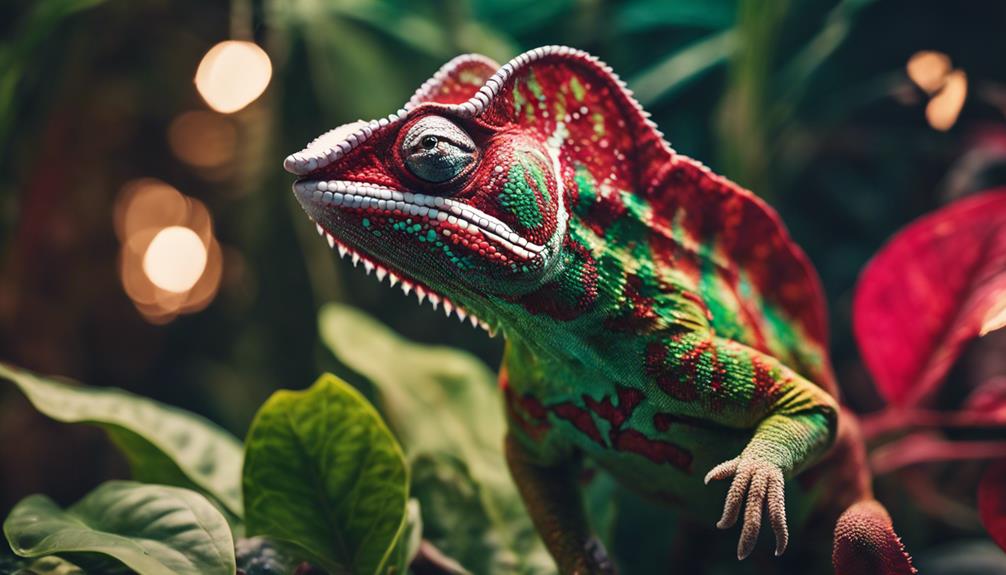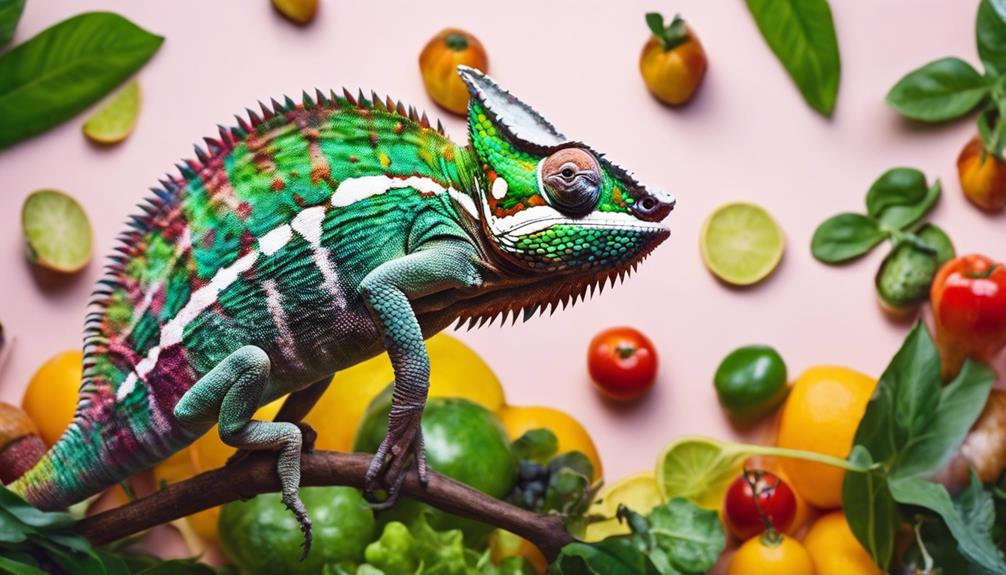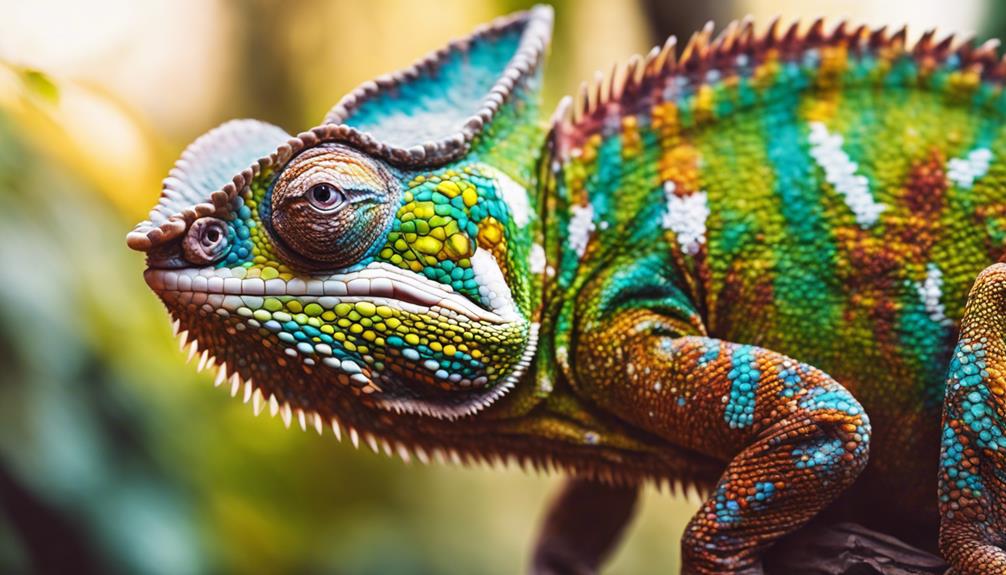Have you ever wondered if caladium plants are truly safe for your chameleon?
While some may believe these vibrant plants add a pop of color to your pet's enclosure, it is important to take into account the potential risks they pose.
Delving into the world of chameleons and plant safety reveals an important aspect that every chameleon owner should be aware of.
The impact of certain plant choices on your chameleon's well-being is a subject that requires careful thought to guarantee a healthy and thriving habitat.
Potential Risks of Caladium Plants
What're the potential risks associated with Caladium plants for chameleons?
Caladium plants pose a significant threat to chameleons due to their toxicity. If chameleons ingest parts of the Caladium plant, such as the leaves or stems, they can experience severe consequences.
The calcium oxalates present in Caladium plants can lead to various issues, particularly affecting the gastrointestinal system of chameleons. Ingestion of these toxic components can result in symptoms like drooling, difficulty swallowing, and irritation of the mouth and throat. Additionally, chameleons may suffer from gastrointestinal disturbances and potential respiratory problems after consuming Caladium plants.
To guarantee the well-being of your chameleons, it's vital to remove any Caladium plants from their habitat promptly. By eliminating the risk of accidental ingestion, you can protect your chameleons from the harmful effects of Caladium toxicity. Remember, prevention is key when it comes to safeguarding your chameleons' health.
Toxicity Concerns for Chameleons
To safeguard the health of your chameleons, it's imperative to understand and address the potential toxicity concerns associated with certain plants in their habitat. Chameleons are particularly vulnerable to the toxic effects of certain plants, such as Caladium. Here are some important points to take into account regarding toxicity concerns for chameleons:
- Safe Plant Lists: It's essential to familiarize yourself with safe plant lists that are non-toxic to chameleons. This will help you create a habitat that's both visually appealing and safe for your pets.
- Toxicity Risks: Plants like Caladium contain substances like calcium oxalates that can be harmful when ingested by chameleons. Understanding which plants pose toxicity risks is essential for the well-being of your pets.
- Preventive Measures: Removing toxic plants like Caladium from your chameleon's habitat is a proactive step to prevent accidental ingestion and potential health issues. Ensuring a safe environment is key to keeping your chameleons healthy and happy.
Symptoms of Caladium Plant Poisoning
Considering the potential risks associated with toxic plants like Caladium for chameleons, understanding the symptoms of Caladium plant poisoning is important for prompt identification and appropriate intervention. When a chameleon ingests parts of a Caladium plant, several symptoms may manifest, indicating poisoning. Here are the common signs of Caladium plant poisoning in chameleons:
| Symptoms | Description | Action |
|---|---|---|
| Oral Irritation | Chameleon may exhibit signs of discomfort in the mouth and throat. | Seek immediate veterinary attention. |
| Drooling | Excessive saliva production beyond normal levels. | Monitor closely for other symptoms. |
| Vomiting | Chameleon regurgitates food or exhibits signs of nausea. | Contact a reptile veterinarian. |
In severe cases, ingestion of Caladium plants can lead to more critical symptoms like swelling of the upper airway, respiratory distress, and potentially life-threatening complications. Chameleons may display these signs shortly after consuming the plant, necessitating urgent veterinary care. To prevent such risks of toxicity, it is crucial to ensure chameleons do not have access to Caladium plants.
Safe Alternatives to Caladiums
Safe alternatives to Caladiums for chameleons include non-toxic plants that can still provide a lush and safe environment for your pet. Here are some options to contemplate:
- Hibiscus: Known for its vibrant flowers, Hibiscus is a safe choice for chameleon habitats. The leaves are non-toxic and can even provide a source of hydration for your pet.
- Romaine: This leafy green isn't only safe but also rich in essential nutrients. Romaine lettuce can be a great addition to your chameleon's diet while making sure their safety.
- Kale: Another safe option is kale, which is packed with vitamins and minerals. It adds variety to the chameleon's diet and can be part of a balanced meal plan.
Opting for non-toxic plants like these ensures that your chameleon stays healthy and happy without the risk of plant toxicity. By choosing safe alternatives, you can create a thriving habitat for your pet while prioritizing their well-being.
Ensuring Chameleon Safety Around Plants
When ensuring the safety of your chameleon around plants, it's essential to be aware of potential toxicities and prioritize the use of non-toxic options. Chameleons, being sensitive creatures, can be negatively affected by toxic plants like Caladium due to their calcium oxalate content.
To safeguard your chameleon's well-being, it's critical to remove any toxic plants, such as Caladium, from their habitat promptly. Educating yourself on which plants are toxic, like Caladium, is fundamental for proper chameleon care.
Opting for safe alternatives such as Hibiscus can help create a secure environment for your chameleon. By choosing non-toxic plant options, you not only enhance the aesthetics of the chameleon enclosure but also ensure a healthy and safe space for your pet.
Frequently Asked Questions
What Plants Are Toxic to Chameleons?
When considering toxic plants for chameleons, it's essential to prioritize their safety. Educate yourself on toxic plants like Caladium and Dieffenbachia, opt for safe options, and prioritize chameleon care to maintain a healthy environment.
What Plants Are Good for Chameleons?
Incorporating spider plants, bromeliads, succulents, air plants, ficus, and snake plants can enhance your chameleon's habitat. These safe choices not only add beauty but also provide a healthy environment for your pet.
What Are the Hanging Plants for Chameleons?
For chameleons, ideal hanging plants like Pothos and Spider Plant offer climbing areas and hydration sources. Remember to provide proper lighting and humidity levels. Decorate with functional setups to mimic natural environments, ensuring a visually appealing chameleon habitat.
Are All Pothos Safe for Chameleons?
When it comes to chameleons, not all Pothos varieties are safe. Some can be toxic due to insoluble calcium oxalate crystals. It's important to choose safe options like Golden Pothos for their diet and habitat.
Conclusion
To sum up, remember that a chameleon's safety is paramount when selecting plants for their habitat. Just as you wouldn't feed a chameleon a chocolate chip cookie, avoid exposing them to toxic Caladium plants.
It's like offering a hot dog to a vegetarian – it simply doesn't align with their needs. Stick to safe alternatives like Romaine or hibiscus leaves to make certain a healthy and thriving environment for your chameleon friend.


